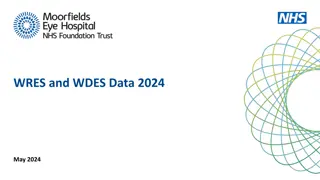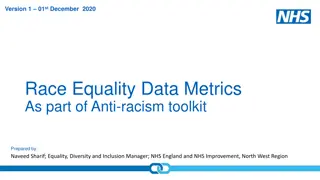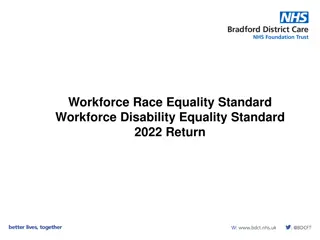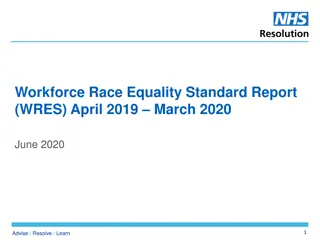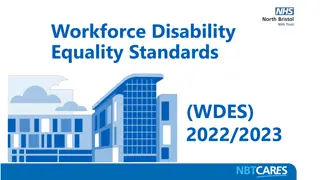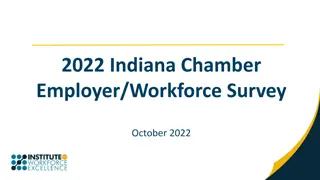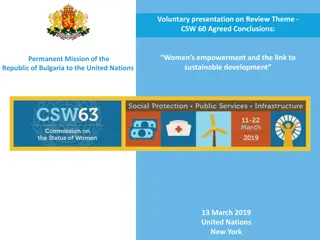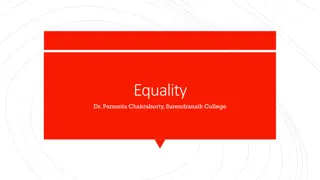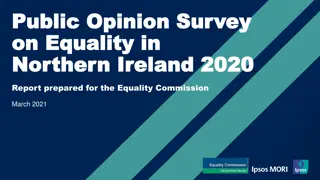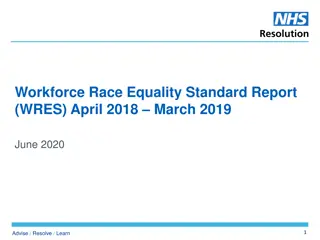Workforce Race Equality Standard Report (WRES) 2023 Overview
The Workforce Race Equality Standard (WRES) was introduced by the NHS in 2015 to address workplace inequalities between Black, Asian, and Minority Ethnic (BAME) staff members and White staff members. The WRES aims to ensure equal access to career opportunities and fair treatment for employees from diverse backgrounds. NHS providers are expected to show progress against indicators of workforce equality, with a focus on board diversity and closing gaps between different ethnic groups. Reporting and action plan development are ongoing, with data typically reported by August 31st and action plans due by October 31st. NECS has been producing WRES reports since 2016 to track performance against key indicators.
Download Presentation

Please find below an Image/Link to download the presentation.
The content on the website is provided AS IS for your information and personal use only. It may not be sold, licensed, or shared on other websites without obtaining consent from the author. Download presentation by click this link. If you encounter any issues during the download, it is possible that the publisher has removed the file from their server.
E N D
Presentation Transcript
Workforce Race Equality Standard Report (WRES) 2023
The WRES - Background and Context Following the Snowy White Peaks Report by Professor Roger Kline in 2014, the NHS Equality and Diversity Council announced on 31 July 2014 that it had agreed action to ensure employees from black and minority ethnic (BME) backgrounds had equal access to career opportunities and received fair treatment in the workplace. Further to this, the NHS introduced the Workforce Race Equality Standards (WRES) in April 2015 in an attempt to review and close gaps in workplace inequalities between Black, Asian and Minority Ethnic (BAME) staff members and White staff members. All NHS organisations were encouraged, and Trusts were mandated, to implement the WRES in an open and transparent way to demonstrate how they were addressing race equality issues. It is also now a requirement for Commissioning Support Units (CSUs) to report on their WRES data. 2
The WRES - Background and Context NHS providers are expected to show progress against a number of indicators of workforce equality, including a specific indicator to address the low numbers of board members from Ethnically Diverse Groups across the organisation NECS has produced a WRES report since 2016 with the aim of making improvements against the 9 indicators The WRES will continue to work to evidence the outcomes of the work that is done, publishing data intelligence and supporting the system by sharing replicable good practice The WRES data is usually reported on by 31st August and an action plan is required by 31st October. However, as of 2022, the reporting period defined by NHSE changed to 31st May of each year for NHS Trusts. There is currently no requirement for CSUs to report on their WRES data for 2023, but further instruction on data submissions will be provided for the 2024 reporting period. However, in line with best practice and to ensure continuous improvement, we are continuing with reporting and action plan development as usual for 2023 3
NECS Performance Against the WRES Indicators 5
WRES Indicator 1: Overall Breakdown of Workforce Data Percentage of colleagues in each of the AfC Bands 1-9 or medical and dental subgroups and VSM (including executive board members) compared with the percentage of colleagues in the overall workforce NECS Workforce Ethnicity Summary 3% 11% 2022/23 Performance compared with 2021/22 (%) 2020/21 2021/22 2022/23 White White 86.4% -1.8% 87.4% 85.6% Ethnically Diverse Groups Ethnically Diverse Groups 7.6% +1.2% 10.3% 11.5% Unknown Unknown 6.0% +0.5% 2.3% 2.8% 86% 6
WRES Indicator 1: Overall Breakdown of Workforce Data Percentage of colleagues in each of the AfC Bands 1-9 or medical and dental subgroups and VSM (including executive board members) compared with the percentage of colleagues in the overall workforce Ethnicity Split for Each Banding Level 2021-22 2022-23 Bands 1-4 Bands 5-7 Bands 8a-8b Bands 8c-VSM Bands 1-4 Bands 5-7 Bands 8a-8b Bands 8c-VSM White 82.8% 88.4% 87.5% 92.1% 83.6% 86.0% 83.5% 92.7% Ethnically Diverse Groups 15.0% 9.5% 9.8% 4.8% 12.4% 11.7% 13.1% 4.8% Unknown 2.2% 2.1% 2.6% 3.2% 4.0% 2.3% 3.3% 2.4% There is a consistent overall increase in the number of colleagues from ethnically diverse groups since 2020/21. However, there has also been a slight increase in the number of colleagues from an unknown ethnicity since 2021/22, which indicates a reduction in ESR completion rates. Additionally, the percentage of colleagues from ethnically diverse groups (11.5%) is lower than the population in England and Wales (18.3%, 2021 Census) In terms of banding, there has been a reduction in the number of colleagues members from ethnically diverse groups for bands 1-4 but an increase for bands 5-7 and 8a-8b, since 2021/22. The number of colleagues from ethnically diverse groups for bands 8c-VSM has not changed. It should also be noted that there has been an increase in the number of colleagues from an unknown ethnicity for each band except 8c-VSM. 7
WRES Indicator 2: Recruitment Ethnicity comparison for: Relative likelihood of colleagues being appointed from shortlisting across all posts 2021/22 2022/23 Relative likelihood of white applicants being appointed Relative likelihood of white applicants being appointed Shortlisted Appointed Shortlisted Appointed Ethnically Diverse Groups 700 52 697 63 2.44 1.46 2068 375 1414 187 White 68 12 42 7 Unknown In 2021/22, the white applicants were 2.44 times more likely to be appointed than applicants from ethnically diverse groups. This has significantly reduced since then, with white applicants now being 1.46 times more likely to be appointed than applicants from ethnically diverse groups. While this reduction is positive, more work still needs to be done to ensure that the likelihood of appointment is equal for all applicants regardless of ethnicity. NB. It should be noted that due to the switch over to the new NHS Jobs platform some recruitment data was lost. As such the figures above may not be entirely representative. 8
WRES Indicator 3: Colleagues Entering Formal Disciplinary Processes The Relative likelihood of ethnically diverse colleagues entering the formal disciplinary process compared with white colleagues, as measured by entry into a formal disciplinary investigation NECS records and monitors all disciplinary cases based on protected characteristics Where the number of colleagues entering a formal disciplinary process is 5 or less, NECS will not disclose or publish the information for reporting purposes to maintain confidentiality and anonymity of individuals subject to such processes The total number of colleagues that entered a formal disciplinary process across all of NECS for the period 1st April 2022 to 31st March 2023 is 5 or less and therefore this information has not been presented in this report. However, it can be seen that colleagues from ethnically diverse groups are 2.48 times more likely to enter a disciplinary process than white colleagues. This is a significant reduction since 2021/22, where ethnically diverse colleagues were 8.52 times more likely to enter a disciplinary process than their white counterparts 9
WRES Indicator 4: Non-mandatory training and continuous professional development Ethnicity comparison for: Relative likelihood of colleagues accessing non-mandatory training and continuous professional development (CPD) 2021/22 2022/23 Relative likelihood of white colleagues accessing non- mandatory training and CPD compared to colleagues from Ethnically Diverse Groups Relative likelihood of white colleagues accessing non- mandatory training and CPD compared to colleagues from Ethnically Diverse Groups No. of colleagues accessing non- mandatory training and CPD No. of colleagues accessing non- mandatory training and CPD Ethnically Diverse Groups 111 126 0.88 1.13 832 1060 White 12 22 Unknown In 2021/22, the white colleagues were slightly less likely (0.88) to have access to non-mandatory training and CPD than colleagues from ethnically diverse groups. This has increased since then, with white colleagues now being slightly more likely (1.13) to access non-mandatory training than colleagues from ethnically diverse groups. This increase is negative, indicating that, since 2021/22, the likelihood of white colleagues accessing non-mandatory training and CPD is higher than colleagues from ethnically diverse groups. 10
WRES Indicators 5-8: Staff Survey Questions Percentage of colleagues that said YES to the WRES questions in the 2022 Staff Survey and a comparison with the 2021 results Staff Survey indicator (WRES) Ethnic Group Survey results In 2022/2023, performance against the staff survey indicators has been largely positive with improvements in experience for both white and ethnically diverse colleagues for indicators 5-7. 2021 2022 Indicator 5- KF 25. Percentage of collegues experiencing harassment, bullying or abuse from patients, relatives or the public in last 12 months White 4.9% 4.7% Ethnically Diverse Groups 3.0% 0.9% There has been an increase in negative experiences for both white and ethnically diverse colleagues for indicator 8, relating to experiencing discrimination from managers, team leaders or other colleagues. White 12.5% 11.1% Indicator 6- KF 26. Percentage of colleagues experiencing harassment, bullying or abuse from colleagues in last 12 months Ethnically Diverse Groups 9.1% 8.2% White 65.3% 67.5% Indicator 7- KF 21. Percentage believing that trust provides equal opportunities for career progression or promotion Additionally, while staff experience has improved overall, it can be seen that colleagues from ethnically diverse groups have a better experience than their white counterparts for indicators 5-6 but a poorer experience for indicators 7-8. Ethnically Diverse Groups 43.9% 51.4% Indicator 8- Q17- In the last 12 months have you personally experienced discrimination at work from Manager/team leader or other Colleagues? White 4.6% 4.8% Ethnically Diverse Groups 7.5% 10.0% 11
WRES Indicator 9: Board Membership Representation Percentage difference between the organisations Board (Exec Team) membership and its overall workforce Board Membership 2022/23 2021/22 Ethnically Diverse Groups Ethnically Diverse Groups White Unknown Unknown Total White Total 5 1 1 7 7 1 0 8 Count 71.4% 14.3% 14.3% 87.5% 12.5% 0.0% Percentage No. of Colleagues in Workforce 2022/23 2021/22 Ethnically Diverse Groups Ethnically Diverse Groups White Unknown Total White Unknown Total 832 111 12 1638 1694 228 56 1978 Count 87.4% 10.3% 2.3% 85.6% 11.5% 2.8% Percentage The data indicates that the ethnically diverse members on Board (Exec Team) is largely representative of the ethnicity demographics in the workforce. Disclosure of ethnicity has also increased since 2021/22, with all board members sharing their ethnicity. 12
What have we done well The number of ethnically diverse colleagues within NECS has been consistently increasing since 2020/2021. There has also been an increase in the number of ethnically diverse colleagues for bands 5-7 and 8a-8b, since 2021/22 In terms of recruitment, there has been an improvement in terms of the relative likelihood of white applicants being appointed when compared with ethnically diverse groups, since 2021/22. There has also been an increase in the number of ethnically diverse applicants appointed to role since 2021/22 Since 2021/22, there has been a significant reduction in the relative likelihood of ethnically diverse colleagues entering disciplinary processes when compared with white colleagues. There has been a reduction in the percentage of white and ethnically diverse colleagues experiencing harassment, bullying and abuse from patients, relatives, the public and colleagues over the last 12 months. There has also been an increase in the percentage of white and ethnically diverse colleagues believing the organisation provides equal opportunities for career progression and promotion. In terms of the Executive Team, the ethnic diversity of members are largely representative of the workforce and there has also been an improvement in ethnicity disclosure rates. 14
Where we need to improve The percentage of colleagues from ethnically diverse groups (11.5%) is lower than the population in England and Wales (18.3%, 2021 Census). Additionally, work should be done to ensure that the ethnic diversity of the workforce for each office location is representative of the local population demographics. In terms of banding, there has been a reduction in the number of colleagues from ethnically diverse groups for bands 1-4. It should also be noted that there has been an increase in the number of colleagues from an unknown ethnicity for each band except 8c-VSM While there has been an increase in the number of ethnically diverse applicants appointed and an improvement in the likelihood of appointment, white applicants are still more likely to be appointed to post than ethnically diverse applicants Ethnically diverse colleagues are still more likely to be subject to a formal disciplinary process than white colleagues The likelihood of white colleagues accessing non-mandatory training and CPD is higher than colleagues from ethnically diverse groups. 15
Where we need to improve continued Since 2021/22, more white and ethnically diverse colleagues are experiencing discrimination from managers, team leaders or other colleagues over the last 12months. Additionally, while colleague experience has improved overall, it can be seen that colleagues from ethnically diverse groups have a better experience than their white counterparts for harassment, bullying or abuse from patients, relatives, members of the public or other colleagues. However less colleagues from ethnically diverse groups than white colleagues believe the organisation provides equal opportunities for career progression or promotion and more ethnically diverse colleagues have experienced discrimination from managers/, team leaders or other colleagues than white colleagues ESR disclosure rates need to be improved across the organisation. Colleague reluctance to share demographic information often relates to their level of trust in an organisation and psychological safety An action plan has been pulled together to tackle the issues highlighted and to improve inclusion throughout the organisation. This relates to all protected characteristics and aims to improve staff experience 16





